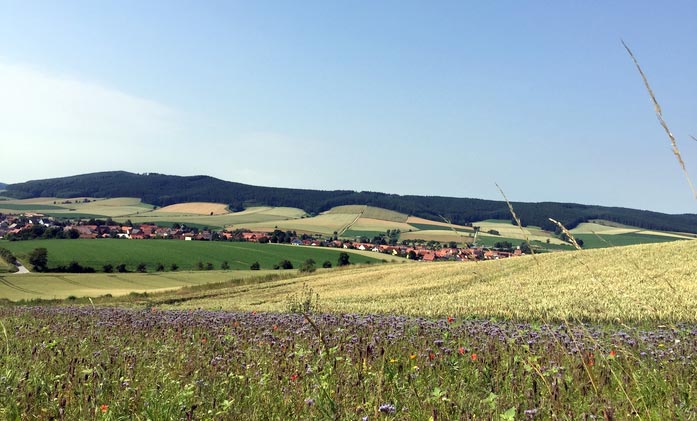Organic farming or flower strips

Flower strips next to a conventional wheat field near Sebexen in the district of Northeim, Germany.
Credit: Constanza Geppert
– which is better for bees?
How effective environmental measures in agriculture are for biodiversity and wild bee populations depends on various factors and your perspective. This is shown by agroecologists from the University of Göttingen, Germany and the Centre for Ecological Research in Vácrátót, Hungary. The research team found that when assessing the effectiveness of different measures, whether in the field (organic farming) or next to the field (flower strips in conventional farming), biodiversity benefits should be evaluated differently. Like-for-like comparisons of environmental measures could easily be misleading, according to the scientists. The research was published in the journal Basic and Applied Ecology.
The researchers studied ten agricultural landscapes near Göttingen, each containing three winter wheat fields: one organic field, one conventional field with flower strips, and one conventional field without flower strips. For two years, the abundance of wild bees was recorded at the edges of each of these thirty fields. The results showed that a simple comparison of the data sampled at specific sites could lead to the conclusion that conventional fields with strips of flowers might attract many more bees than organic fields but this is not the full story.
“When we looked more closely, this did not give us a complete picture because it did not take into account that flower strips only cover about five percent of conventional fields which has significantly fewer bees overall than the organic farmland,” explains Professor Teja Tscharntke, Department of Agroecology at Göttingen University. Dr Péter Batáry, group leader at the Centre for Organic Research in Vácrátót, Hungary goes onto say: “In short, organic farming, which typically has more wild plants than conventional fields, is actually more successful than conventional fields with flower strips in promoting bees.”
The missing piece of the jigsaw is the fact that fields of grain in organic farming yield only half the harvest of conventional farming. When the loss in wheat yield is taken into account, a ten-hectare area of organic farmland should be compared to five hectares of conventional farmland plus five hectares of flower strips, which would lead to 3.5 times more bees but the same yield. In this scenario, organic farming would not be the best way to support wild bees.
“These data and considerations show that different benchmarks and criteria should be taken into account when evaluating agri-environmental measures. It is only when we take into account the area along with the yield together with the type of farming that we can achieve a balanced understanding of the ecological and economic effectiveness of environmental measures,” the authors say.
Journal: Basic and Applied Ecology
DOI: 10.1016/j.baae.2022.05.001
Method of Research: Experimental study
Subject of Research: Not applicable
Article Title: Scale-dependent effectiveness of on-field vs. off-field agri-environmental measures for wild bees
Article Publication Date: 15-May-2022
All latest news from the category: Ecology, The Environment and Conservation
This complex theme deals primarily with interactions between organisms and the environmental factors that impact them, but to a greater extent between individual inanimate environmental factors.
innovations-report offers informative reports and articles on topics such as climate protection, landscape conservation, ecological systems, wildlife and nature parks and ecosystem efficiency and balance.
Newest articles

Trotting robots reveal emergence of animal gait transitions
A four-legged robot trained with machine learning by EPFL researchers has learned to avoid falls by spontaneously switching between walking, trotting, and pronking – a milestone for roboticists as well…

Innovation promises to prevent power pole-top fires
Engineers in Australia have found a new way to make power-pole insulators resistant to fire and electrical sparking, promising to prevent dangerous pole-top fires and reduce blackouts. Pole-top fires pose…

Possible alternative to antibiotics produced by bacteria
Antibacterial substance from staphylococci discovered with new mechanism of action against natural competitors. Many bacteria produce substances to gain an advantage over competitors in their highly competitive natural environment. Researchers…





















